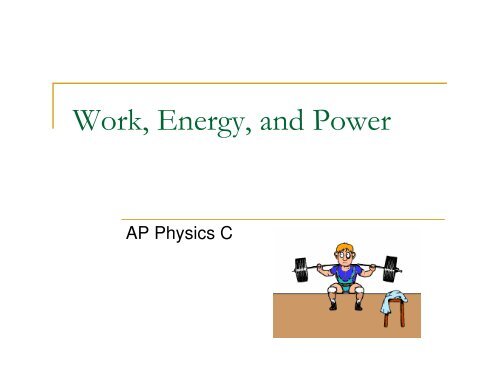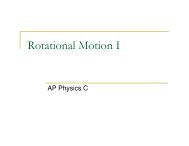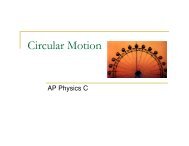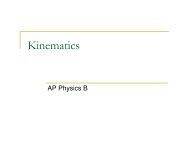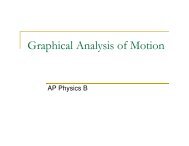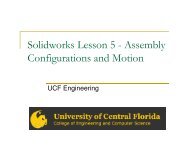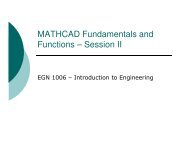Work, Energy, and Power
Work, Energy, and Power
Work, Energy, and Power
Create successful ePaper yourself
Turn your PDF publications into a flip-book with our unique Google optimized e-Paper software.
<strong>Work</strong>, <strong>Energy</strong>, <strong>and</strong> <strong>Power</strong><br />
AP Physics C
There are many different TYPES of<br />
<strong>Energy</strong>.<br />
<strong>Energy</strong> is expressed<br />
in JOULES (J)<br />
4.19 J = 1 calorie<br />
<strong>Energy</strong> can be<br />
expressed more<br />
specifically by using<br />
the term WORK(W)<br />
<strong>Work</strong> = The Scalar Dot Product between Force <strong>and</strong> Displacement.<br />
So that means if you apply a force on an object <strong>and</strong> it covers a<br />
displacement you have supplied ENERGY or done WORK on that<br />
object.
Scalar Dot Product?<br />
A product is obviously a result of<br />
multiplying 2 numbers. A<br />
scalar is a quantity with NO<br />
DIRECTION. So basically<br />
<strong>Work</strong> is found by multiplying<br />
the Force times the<br />
displacement <strong>and</strong> result is<br />
ENERGY, which has no<br />
direction associated with it.<br />
W = Fx<br />
Area = Base x Height<br />
W<br />
r<br />
=<br />
=<br />
r r rr<br />
F • ∆r<br />
→ Fr<br />
cosθ<br />
displacement<br />
vector<br />
A dot product is basically a CONSTRAINT<br />
on the formula. In this case it means that<br />
F <strong>and</strong> x MUST be parallel. To ensure that<br />
they are parallel we add the cosine on the<br />
end.
<strong>Work</strong><br />
The VERTICAL component of the force DOES NOT<br />
cause the block to move the right. The energy imparted to<br />
the box is evident by its motion to the right. Therefore<br />
ONLY the HORIZONTAL COMPONENT of the force<br />
actually creates energy or WORK.<br />
When the FORCE <strong>and</strong> DISPLACEMENT are in the SAME<br />
DIRECTION you get a POSITIVE WORK VALUE. The<br />
ANGLE between the force <strong>and</strong> displacement is ZERO<br />
degrees. What happens when you put this in for the<br />
COSINE?<br />
When the FORCE <strong>and</strong> DISPLACEMENT are in the<br />
OPPOSITE direction, yet still on the same axis, you get a<br />
NEGATIVE WORK VALUE. This negative doesn't mean<br />
the direction!!!! IT simply means that the force <strong>and</strong><br />
displacement oppose each other. The ANGLE between the<br />
force <strong>and</strong> displacement in this case is 180 degrees. What<br />
happens when you put this in for the COSINE?<br />
When the FORCE <strong>and</strong> DISPLACEMENT are<br />
PERPENDICULAR, you get NO WORK!!! The ANGLE<br />
between the force <strong>and</strong> displacement in this case is 90<br />
degrees. What happens when you put this in for the<br />
COSINE?
Example<br />
W<br />
W<br />
W<br />
W<br />
W<br />
=<br />
=<br />
=<br />
=<br />
=<br />
F • r<br />
F<br />
r<br />
346.<br />
4<br />
346.<br />
4<br />
cosθ<br />
25 16 cos30<br />
Nm<br />
J<br />
W<br />
W<br />
=<br />
=<br />
F • r<br />
F<br />
r<br />
cosθ<br />
A box of mass m = 2.0 kg is moving over a<br />
frictional floor ( u k = 0.3) has a force whose<br />
magnitude is F = 25 N applied to it at an<br />
angle of 30 degrees, as shown to the left.<br />
The box is observed to move 16 meters in<br />
the horizontal direction before falling off the<br />
table.<br />
a) How much work does F do before taking<br />
the plunge?
Example cont’<br />
What if we had done this in UNIT VECTOR notation?<br />
F<br />
W<br />
W<br />
W<br />
W<br />
=<br />
21.<br />
65iˆ<br />
+<br />
= ( F<br />
=<br />
=<br />
=<br />
x<br />
• r<br />
346.<br />
4<br />
346.<br />
4<br />
x<br />
( 21.<br />
65<br />
Nm<br />
J<br />
)<br />
12.<br />
5<br />
+ ( F<br />
ˆj<br />
y<br />
•16)<br />
+<br />
• r<br />
y<br />
)<br />
( 12.<br />
5<br />
•<br />
0)
Example cont’<br />
F f<br />
F n<br />
Note: This “negative” does not<br />
specify a direction in this case<br />
since WORK is a SCALAR. It<br />
simply means that the force is<br />
involved in slowing the object<br />
down.<br />
W<br />
W<br />
W<br />
W<br />
How much work does the<br />
FORCE NORMAL do <strong>and</strong><br />
Why?<br />
= F • r<br />
=<br />
=<br />
F<br />
F<br />
= 0<br />
N<br />
J<br />
r<br />
cosθ<br />
16<br />
cos90<br />
There is NO WORK since<br />
“F” <strong>and</strong> “r” are perpendicular.<br />
How much work does the frictional force do?<br />
W<br />
W<br />
W<br />
W<br />
W<br />
W<br />
=<br />
=<br />
=<br />
=<br />
=<br />
F<br />
f<br />
F<br />
f<br />
µ F<br />
• r<br />
N<br />
r<br />
cosθ<br />
r<br />
cosθ<br />
= µ ( mg − F cosθ<br />
) r cosθ<br />
0.<br />
3(<br />
2(<br />
9.<br />
8)<br />
-34.08 J<br />
−<br />
25cos<br />
30)<br />
16<br />
cos180
What if the FORCE IS NOT CONSTANT?<br />
Is this function, with respect to “x” ? NO!<br />
W<br />
W<br />
=<br />
=<br />
m<br />
F<br />
dx<br />
∫ ∫<br />
( a)<br />
→<br />
dx<br />
( ma)<br />
dx<br />
→<br />
m<br />
∫ ∫<br />
dv<br />
( ) dx<br />
dt<br />
The function here MUST be a “FORCE”<br />
function with respect to “x” or “r”. Let’s look<br />
at a POPULAR force function.<br />
F Net =<br />
ma<br />
You can still integrate the function, it simply needs to be modified so that it<br />
fits the model accordingly.<br />
dx<br />
W = m (<br />
) dv<br />
dt<br />
W<br />
=<br />
m<br />
∫ v<br />
∫<br />
v o<br />
v<br />
dv<br />
→<br />
→<br />
m<br />
∫<br />
v<br />
dv
<strong>Work</strong>-<strong>Energy</strong> Theorem<br />
2<br />
2<br />
)<br />
2<br />
2<br />
(<br />
)<br />
|<br />
2<br />
|<br />
(<br />
)<br />
(<br />
2<br />
2<br />
2<br />
2<br />
2<br />
o<br />
o<br />
v<br />
v<br />
v<br />
v<br />
mv<br />
mv<br />
W<br />
v<br />
v<br />
m<br />
v<br />
m<br />
W<br />
dv<br />
v<br />
m<br />
W<br />
dv<br />
v<br />
m<br />
dv<br />
dt<br />
dx<br />
m<br />
W<br />
o<br />
o<br />
−<br />
=<br />
−<br />
→<br />
=<br />
=<br />
→<br />
=<br />
∫<br />
∫<br />
∫<br />
K<br />
W<br />
mv<br />
K<br />
∆<br />
=<br />
=<br />
=<br />
2<br />
2<br />
1<br />
<strong>Energy</strong><br />
Kinetic<br />
Kinetic energy is the ENERGY of MOTION.
Example W=Frcosθ<br />
A 70 kg base-runner begins to slide into second base when moving<br />
at a speed of 4.0 m/s. The coefficient of kinetic friction between<br />
his clothes <strong>and</strong> the earth is 0.70. He slides so that his speed is<br />
zero just as he reaches the base (a) How much energy is lost<br />
due to friction acting on the runner? (b) How far does he slide?<br />
a)<br />
W<br />
W<br />
W<br />
f<br />
f<br />
f<br />
= 0 −<br />
=<br />
= ∆K<br />
1<br />
2<br />
-560 J<br />
mv<br />
2<br />
o<br />
→ −<br />
− 560<br />
x<br />
=<br />
1 ( 70)(<br />
4)<br />
2<br />
W f = Ff<br />
r cosθ<br />
=<br />
1.17 m<br />
2<br />
=<br />
= µ F → µ mg<br />
Ff n<br />
( 0.<br />
70)(<br />
70)(<br />
9.<br />
8)<br />
= 480.2 N<br />
( 480.<br />
2)<br />
r(cos180)
Another varying force example..<br />
A ball hangs from a rope attached<br />
to a ceiling as shown. A variable<br />
force F is applied to the ball so<br />
that:<br />
•F is always horizontal<br />
•F’s magnitude varies so that the ball<br />
moves up the arc at a constant<br />
speed.<br />
•The ball’s velocity is very low<br />
Assuming the ball’s mass is m, how much work does F do as it moves from<br />
θθθθ = 0 to θ θ θ θ = θθθθ 1 ?
Example Cont’<br />
θ<br />
θ<br />
θ<br />
θ<br />
θ<br />
tan<br />
sin<br />
)<br />
cos<br />
(<br />
sin<br />
cos<br />
mg<br />
mg<br />
F<br />
F<br />
T<br />
mg<br />
T<br />
=<br />
=<br />
=<br />
=<br />
T<br />
mg<br />
Tcosθ<br />
Tsinθ<br />
dr<br />
dy<br />
or<br />
dx<br />
dy<br />
dr<br />
mg<br />
dr<br />
F<br />
W<br />
=<br />
→<br />
= ∫ ∫<br />
θ<br />
θ<br />
tan<br />
)<br />
tan<br />
(
Example Cont’<br />
W<br />
W<br />
W<br />
W<br />
=<br />
=<br />
=<br />
∫<br />
mg tanθ dr →<br />
mg<br />
mg<br />
dy<br />
y<br />
y<br />
= mgy − mgy<br />
o<br />
→<br />
mg<br />
∫ ∫<br />
| y|<br />
o<br />
y<br />
y<br />
o<br />
∫<br />
dy<br />
mg(<br />
) dr<br />
dr<br />
dy<br />
→ mg(<br />
y −<br />
y<br />
o<br />
)<br />
U<br />
W<br />
= Potential <strong>Energy</strong><br />
= ∆U<br />
mgy<br />
The energy of POSITION or<br />
STORED ENERGY is called<br />
Potential <strong>Energy</strong>!<br />
=<br />
=<br />
mgh
Something is missing….<br />
Suppose the mass was thrown UPWARD.<br />
How much work does gravity do on the<br />
body as it executes the motion?<br />
W<br />
W<br />
W<br />
W<br />
gravity<br />
gravity<br />
gravity<br />
gravity<br />
r r<br />
= F • r = Fr cosθ<br />
= mg(<br />
y<br />
= −mg∆y<br />
= −∆U<br />
1<br />
Consider a mass m that moves from position 1 ( y1)<br />
to position 2 m,(y2), moving with a constant velocity.<br />
How much work does gravity do on the body as it<br />
executes the motion? r<br />
−<br />
y<br />
2<br />
)<br />
cos180<br />
W<br />
W<br />
W<br />
W<br />
gravity<br />
gravity<br />
gravity<br />
gravity<br />
r<br />
= F • r = Fr cosθ<br />
= mg(<br />
y<br />
= −mg∆y<br />
= −∆U<br />
2<br />
−<br />
In both cases, the negative<br />
sign is supplied<br />
y<br />
1<br />
) cos0
The bottom line..<br />
The amount of <strong>Work</strong> gravity does on a body is<br />
PATH INDEPENDANT. Force fields that act<br />
this way are CONSERVATIVE FORCES<br />
FIELDS. If the above is true, the amount of<br />
work done on a body that moves around a<br />
CLOSED PATH in the field will always be<br />
ZERO<br />
FRICTION is a non conservative force. By NON-CONSERVATIVE<br />
we mean it DEPENDS on the PATH. If a body slides up, <strong>and</strong> then<br />
back down an incline the total work done by friction is NOT ZERO.<br />
When the direction of motion reverses, so does the force <strong>and</strong><br />
friction will do NEGATIVE WORK in BOTH directions.
<strong>Energy</strong> is CONSERVED!<br />
W<br />
K<br />
K<br />
K<br />
o<br />
=<br />
−<br />
−<br />
∆K<br />
K<br />
K<br />
o<br />
o<br />
+ U<br />
o<br />
<strong>Energy</strong><br />
=<br />
=<br />
=<br />
=<br />
before<br />
−∆U<br />
−(<br />
U<br />
−U<br />
K<br />
=<br />
−U<br />
+ U<br />
+ U<br />
o<br />
o<br />
)<br />
<strong>Energy</strong><br />
after
Example<br />
A 2.0 m pendulum is released from rest when the<br />
support string is at an angle of 25 degrees with the<br />
vertical. What is the speed of the bob at the bottom<br />
of the string?<br />
θ Lcosθ<br />
h<br />
E B = E A<br />
UO = K<br />
mgho = 1/2mv2 gho = 1/2v2 1.83 = v2 1.35 m/s = v<br />
L<br />
h = L – Lcosθ<br />
h = 2-2cosθ<br />
h = 0.187 m
How to we measure energy?<br />
One of the things we do everyday is measure how<br />
much energy we use. The rate at which we use it<br />
determines the amount we pay to our utility<br />
company. Since WORK is energy the rate at which<br />
work is done is referred to as POWER.<br />
The unit is either Joules per second or<br />
commonly called the WATT.<br />
To the left are several various versions of<br />
this formula, including some various<br />
Calculus variations.


